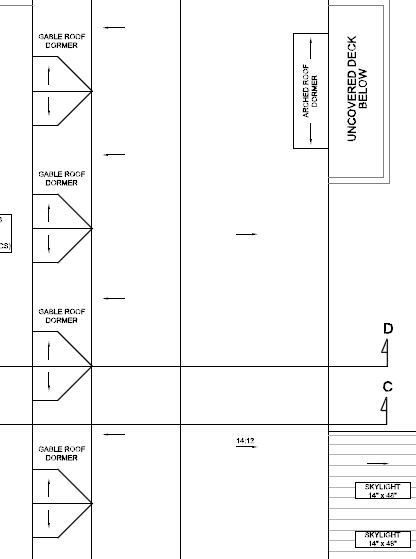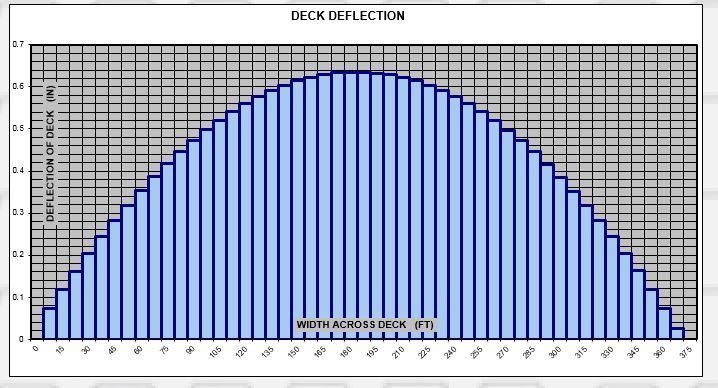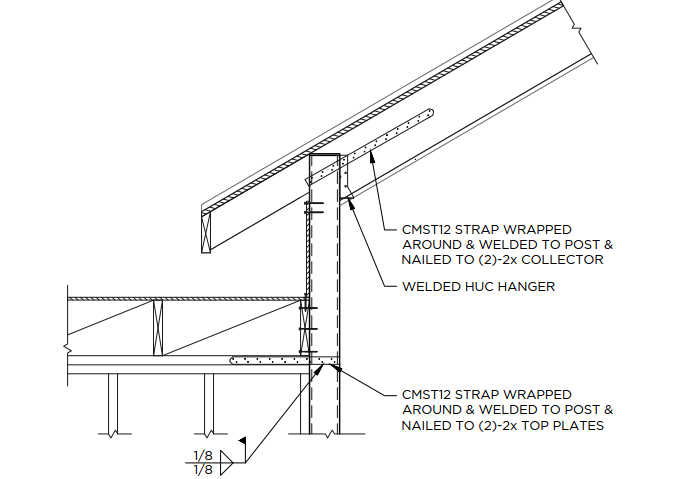JAE said:
Your sketch assumes flexural deflection. Diaphragms have significant shear deflections so that 3x rotation, and your sketch, isn't all that meaningful or correct...Even with your not-correct flexurally deformed diaphragm,
While I agree that wood diaphragms undergo significant shear deformation, the assertion that my flexural analysis is meaningless or incorrect is seriously flawed.
1) Just because shear deformations exist, that's no reason not to bother looking at flexural stresses strains.
2) If flexural stresses and strains are not important or relevant, then why bother with chords? We certainly don't bother with them to deal with shear deformation.
3) Shear deformations are
additive to flexural deformations. As such, you'll see the 3X strain shown in my sketch and then some
more drift as a result of shear deformation.
JAE said:
you'd still work backwards to find a half-roof diaphragm stiffness that would limit that arc. I use the term back-calculating to suggest that you'd start with the limit on deflection and then back-determine the necessary diaphragm stiffness to accomplish that.
Ok. But you're calculating the arc length incorrectly by ignoring the role that diaphragm depth plays. So your back calculation, by merely enforcing a drift limit,
isn't enforcing any particular limit on in-plane diaphragm strain. Less drift begets less strain, obviously, but strain is not quantified by your suggested procedure.
JAE said:
For a usual range of 3-story wood framed buildings, that drift limit really minimizes the resulting arc length of the eave edge.
While I agree with the conclusion, I still contend that your estimation of the resulting arc length is flawed as I discussed previously.
JAE said:
Wood is a very VERY forgiving material in construction and the use of a half diaphragm in this particular case, just isn't that big of a concern. I've even done this on other designs and with no problems.
I agree and have acknowledged as much several times here. I do a version of the same thing myself, sometimes even in steel. This expanded discussion is theoretical only in my opinion. That said, I think that there's presumption in suggesting that a short history of successful performance represents a glowing endorsement of the half diaphragm method. Roof diaphragms essentially
never have problems. And that includes all of the real world diaphragms that have discontinuous chords, no heel blocking, no ridge blocking, and no properly detailed colledtors. They work because these systems are often heavily redundant, not because of the spiffy tricks of structural engineers.
JAE said:
What Mike says above, adding a collector of sorts to the top of the dormers, could be considered as well...just more cost and to accomplish what, though.
Sure. I was the first to suggest this strategy up at the top.
KootK said:
Another alternative would be to step your chord 4'-3" back up into the roof at the dormers and provide a chord segment there effectively detailed to lap with the wall plates.
I would say that:
1) In theory, it accomplishes a design that gives proper credence to realistic deformations and strain compatibility. It also produces a design in compliance with the methods that seem to be becoming the state of the art in our industry.
2) In practice, it probably accomplishes nothing at all except, perhaps, to spare the diaphragm some localized damage at the re-entrant corners of the notch during a very extreme event.
I like to debate structural engineering theory -- a lot. If I challenge you on something, know that I'm doing so because I respect your opinion enough to either change it or adopt it.






